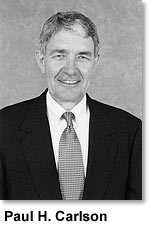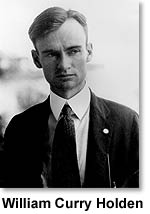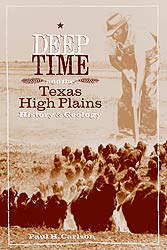Research/Academic Showcase
Writing Down the Bones
Professor Writes History Focusing on Lubbock Lake Landmark site
 An afternoon trip with his grandson to the Lubbock
Lake Landmark site three years ago sent Paul H. Carlson, director of the Center for the Southwest at Texas Tech University, on a journey that he didn't expect.
An afternoon trip with his grandson to the Lubbock
Lake Landmark site three years ago sent Paul H. Carlson, director of the Center for the Southwest at Texas Tech University, on a journey that he didn't expect.
That journey lasted two and a half years, a period in which he pored over as many as 400 archeological, anthropological and geological papers and books about the location, which is one of the nation's most important archeological sites. The result of his efforts is "Deep Time and the Texas High Plains: History and Geology," a historical account of the site and the Llano Estacado published in November by Texas Tech University Press.
 Carlson says he decided to write the book after several visits to the site and its gift shop, where there weren't many books.
Carlson says he decided to write the book after several visits to the site and its gift shop, where there weren't many books.
"They had some coloring books and some technical studies. But there was no general history on the Lubbock Lake site. I wanted to learn more, so I decided to try my hand at a little book," he says.
Carlson describes the formation of the Llano Estacado, how animals from mammoths to ancient bison came to the site for water, and how game animals might have drawn the first humans to the lake about 12,000 years ago.
 The site's archaeological importance became evident in the mid-1930s, Carlson says. During the Dust Bowl, farmers and homeowners drilled more wells for irrigation and drinking water, which dropped the water table in the Ogallala Aquifer. More demand on the aquifer caused the lake to dry up.
The site's archaeological importance became evident in the mid-1930s, Carlson says. During the Dust Bowl, farmers and homeowners drilled more wells for irrigation and drinking water, which dropped the water table in the Ogallala Aquifer. More demand on the aquifer caused the lake to dry up.
 City officials dredged the lake, thinking the springs feeding it had filled
with silt. As the lake filled again, two cousins exploring the area found
an ancient Folsom-era spearhead and took it to William Curry Holden –
a key player in Texas Tech University's Department of History and Anthropology.
City officials dredged the lake, thinking the springs feeding it had filled
with silt. As the lake filled again, two cousins exploring the area found
an ancient Folsom-era spearhead and took it to William Curry Holden –
a key player in Texas Tech University's Department of History and Anthropology.
Holden immediately recognized the significance of the finding and began excavations, and the lake area became one of the most important archaeological sites in the country. Remains of ancient armadillos, bears, elephants and evidence of early humans have been uncovered by archaeologists.
 "It's a significant place for historians," Carlson says. "Here was a
waterhole for thousands of years that watered buffalo herds. When the Indians
came, it served as a source of water for them. When the Comanches and Apaches
came with their European horses, they watered thousands of their horses at
the site. After cattlemen arrived with their herds, the place watered tens
of thousands of cattle.
"It's a significant place for historians," Carlson says. "Here was a
waterhole for thousands of years that watered buffalo herds. When the Indians
came, it served as a source of water for them. When the Comanches and Apaches
came with their European horses, they watered thousands of their horses at
the site. After cattlemen arrived with their herds, the place watered tens
of thousands of cattle.
"I think the whole story is fascinating, and that's why I wanted to tell it. We can get bits and pieces of the story here and there, but my book tries to tell a larger story," he says.

